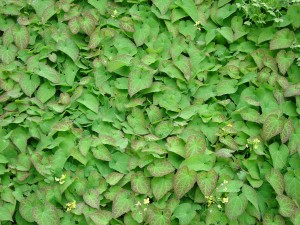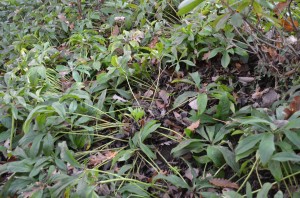Foliage of many popular evergreen perennials often appear tattered after a long cold winter. Coralbells (Heuchera spp.), foam flowers (Tiarella spp.), monkeygrass (Liriope spp.), fairy wings (Epimedium spp.), creeping phlox (Phlox subulata), periwinkle (Vinca minor), Japanese spurge (Pachysandra terminalis), and Christmas fern (Polystichum acrostichoides) are stunning evergreen groundcovers.
The solution is simple– just prune them. In late winter tidy up evergreen perennials before new growth or flowers appear. New growth on coralbells appears at the plant center. If spring growth has already started, do not trim off the new foliage as it may retard plant growth. Feed perennials with granular 10-10-10 or equivalent fertilizer and they’re ready for a new growing season.
Many low spreading ground cover perennials, such as fairy wings, perwinkle, Japanese spurge, and Christmas ferns, can be mowed down before new spring growth and flowers arise. Set the mower height at 4-5 inches tall, in “mulching mode”, and slowly grind though the bed, and leave the debris for long term improvement of the soil.
Prune off oldest low (basal) foliage of Christmas rose (H. niger) and Lenten rose (Helleborus x hybridus) in late autumn as new growth emerges or wait for winter flowering has begun. Christmas rose blooms around the winter holidays while Lenten roses flower in February and March. Removal of old foliage gives plants a fresh bouquet appearance.
Add the clippings to the compost bin unless the plant debris is heavily disease infected.



 Posted in
Posted in 
